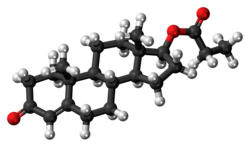 | |
 | |
| Clinical data | |
|---|---|
| Trade names | Testoviron, others |
| Other names | TP; Testosterone propanoate; Testosterone 17β-propanoate; Propionyltestosterone; NSC-9166 |
| Routes of administration | Intramuscular injection, buccal |
| Drug class | Androgen; Anabolic steroid; Androgen ester |
| Legal status | |
| Legal status |
|
| Pharmacokinetic data | |
| Bioavailability | Oral: very low Intramuscular: very high |
| Metabolism | Liver |
| Elimination half-life | Intramuscular: 0.8 days (~20 hours)[1][2][3] |
| Excretion | Urine |
| Identifiers | |
| |
| CAS Number | |
| PubChem CID | |
| DrugBank | |
| ChemSpider | |
| UNII | |
| KEGG | |
| ChEBI | |
| ChEMBL | |
| CompTox Dashboard (EPA) | |
| ECHA InfoCard | 100.000.319 |
| Chemical and physical data | |
| Formula | C22H32O3 |
| Molar mass | 344.495 g·mol−1 |
| 3D model (JSmol) | |
| |
| |
Testosterone propionate, sold under the brand name Testoviron among others, is an androgen and anabolic steroid (AAS) medication which is used mainly in the treatment of low testosterone levels in men.[4][1][5] It has also been used to treat breast cancer in women.[6] It is given by injection into muscle usually once every two to three days.[5][7][8]
Side effects of testosterone propionate include symptoms of masculinization like acne, increased hair growth, voice changes, and increased sexual desire.[5] Testosterone supplementation is also known to reduce the threshold for aggressive behavior in men.[9] The drug is a synthetic androgen and anabolic steroid and hence is an agonist of the androgen receptor (AR), the biological target of androgens like testosterone and dihydrotestosterone (DHT).[10][5] It has strong androgenic effects and moderate anabolic effects, which make it useful for producing masculinization and suitable for androgen replacement therapy.[5] Testosterone propionate is a testosterone ester and a relatively short-acting prodrug of testosterone in the body.[7][4][1] Because of this, it is considered to be a natural and bioidentical form of testosterone.[11]
Testosterone propionate was discovered in 1936 and was introduced for medical use in 1937.[12][4] It was the first testosterone ester to be marketed, and was the major form of testosterone used in medicine until about 1960.[4][5] The introduction of longer-acting testosterone esters like testosterone enanthate, testosterone cypionate, and testosterone undecanoate starting in the 1950s resulted in testosterone propionate mostly being superseded.[4][5] As such, it is rarely used today.[5][13] In addition to its medical use, testosterone propionate is used to improve physique and performance.[5] The drug is a controlled substance in many countries and so non-medical use is generally illicit.[5]
- ^ a b c Nieschlag E, Behre HM (13 January 2010). "Testosterone Therapy". In Nieschlag E, Behre HM, Nieschlag S (eds.). Andrology: Male Reproductive Health and Dysfunction. Springer Science & Business Media. pp. 441–446. ISBN 978-3-540-78355-8.
- ^ Cite error: The named reference
pmid10229906was invoked but never defined (see the help page). - ^ Rastrelli G, Reisman Y, Ferri S, Prontera O, Sforza A, Maggi M, Corona G (2019). "Testosterone Replacement Therapy". Sexual Medicine. Springer. pp. 79–93. doi:10.1007/978-981-13-1226-7_8. ISBN 978-981-13-1225-0. S2CID 240176927.
- ^ a b c d e Behre HM, Nieschlag E (26 July 2012). "Testosterone preparations for clinical use in males". In Nieschlag E, Behre HM, Nieschlag S (eds.). Testosterone: Action, Deficiency, Substitution. Cambridge University Press. pp. 9, 315–. ISBN 978-1-107-01290-5.
- ^ a b c d e f g h i j Llewellyn W (2011). Anabolics. Molecular Nutrition Llc. pp. 357–361, 413, 426, 607, 677. ISBN 978-0-9828280-1-4.
- ^ Bolour S, Braunstein G (2005). "Testosterone therapy in women: a review". International Journal of Impotence Research. 17 (5): 399–408. doi:10.1038/sj.ijir.3901334. PMID 15889125. S2CID 6461717.
- ^ a b Becker KL (2001). Principles and Practice of Endocrinology and Metabolism. Lippincott Williams & Wilkins. pp. 1185, 1187. ISBN 978-0-7817-1750-2.
- ^ Payne AH, Hardy MP (28 October 2007). The Leydig Cell in Health and Disease. Springer Science & Business Media. pp. 423–. ISBN 978-1-59745-453-7.
- ^ Geniole SN, Bird BM, McVittie JS, Purcell RB, Archer J, Carré JM (July 2020). "Is testosterone linked to human aggression? A meta-analytic examination of the relationship between baseline, dynamic, and manipulated testosterone on human aggression" (PDF). Hormones and Behavior. 123: 104644. doi:10.1016/j.yhbeh.2019.104644. PMID 31785281. S2CID 208515589.
- ^ Kicman AT (June 2008). "Pharmacology of anabolic steroids". British Journal of Pharmacology. 154 (3): 502–521. doi:10.1038/bjp.2008.165. PMC 2439524. PMID 18500378.
- ^ Santoro N, Braunstein GD, Butts CL, Martin KA, McDermott M, Pinkerton JV (April 2016). "Compounded Bioidentical Hormones in Endocrinology Practice: An Endocrine Society Scientific Statement". The Journal of Clinical Endocrinology and Metabolism. 101 (4): 1318–1343. doi:10.1210/jc.2016-1271. PMID 27032319.
- ^ Cite error: The named reference
pmid16746360was invoked but never defined (see the help page). - ^ Cite error: The named reference
ChappleSteers2011was invoked but never defined (see the help page).